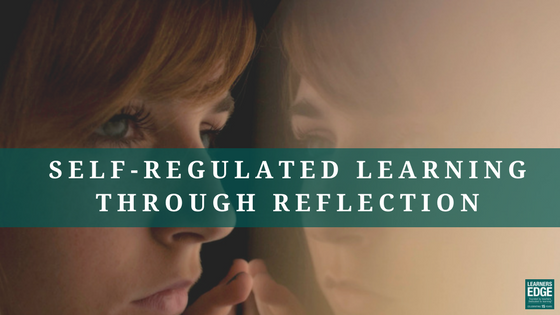As all educators know, the act of reflection and how it relates to learning is not a new concept. Early 20th century progressive educator, John Dewey, noted, “We do not learn from experience…we learn from reflecting on the experience.” Well before John Dewey’s time, Spanish philosopher of the 1600s, Baltasar Gracian stated, “Self-reflection is the school of wisdom.” We at Learners Edge tend to agree!
But how is reflection linked to self-regulation and why is it such an important component of the learning process? According to author, Richard M. Cash, self-regulation for learning is defined as, a process in which the learner manages and controls his or her capacities of affect (feelings), behavior, and cognition (thinking)-the ABCs-to engage in learning, and improve achievement and performance. Cash goes on to explain, “For students to be fully self-regulated, we must assist them in developing an effective way to reflect not only on what they have learned (the cognitive dimension), but also on the feelings and motivations associated with learning (the affective dimension), and what they did to achieve (behavioral dimension).” Giving students time and opportunities to interpret and analyze helps them self-regulate and solidify what they have learned, ultimately leading to success.
So how can you support your students with self-regulated learning through reflection? Here are some of our favorite self reflection exercises to use throughout the learning process.
3-Column Journals
Journaling can be an effective way to support self-regulated learning. To keep students’ thoughts organized, have them make three columns labeled A (for Affect-feelings associated with learning), B (for Behaviors related to learning), and C (for Cognition-thoughts and questions associated with learning). Require students to write at least one sentence in each column (more for older students). Below is an example of a journal entry.
A (Affect) | B (Behaviors) | C (Cognition) |
Today I felt excited about coming to school because we were going to begin our science fair projects. | I worked hard with my science partner to complete our project outline today. | It looks like the science fair project will be more work than I thought. I’m going to ask my partner if we can work on it together after school this week. |
Thumbs Up/Thumbs Down
You may have asked your students to give you a thumbs up or a thumbs down as a quick assessment strategy to gauge student learning. You can take this a step further by asking students write down what went well for them, connections they made, and what they found enjoyable or interesting during instruction (thumbs up). Then require students to write what didn’t go well for them, what they were not able to connect with, and/or what was least enjoyable or least interesting during the lesson (thumbs down).
3-2-1
At the end of a lesson or a chapter, have students list 3 new insights, 2 connections made, and 1 question they still have. This is an effective way to invite reflection while gathering valuable formative assessment data.
Quick Sketch
Your visual learners will appreciate this one. Provide your students with an index card or a post-it note and have your students roughly sketch a picture/visual representation of the gist of what they have learned after reading a chapter or upon completion of a lesson. Students can include a few words or sentences to explain their sketches, along with any thoughts and feelings associated with learning.
As stated by Confucius, “Learning without reflection is a waste. Reflection without learning is dangerous.” Reflection is a powerful teaching practice indeed. How will you implement reflection practices into your lessons for your students? Interested in learning about more strategies to support your students with self-regulated learning in your classroom? Please check out Course 5008: Ready to Learn Through Self-Regulation.
Sources:
- Cash, R. (2016). Self-Regulation in the classroom: helping students learn how to learn. Golden Valley: Free Spirit Publishing:http://www.readwritethink.org/files/resources/printouts/KWL%20Chart.pdf
Learners Edge is passionately committed to providing you with continuing education coursework, materials, and tools that will help you succeed in your classroom and in your career.
Offering more than 100 print-based or online courses for teachers, you can earn the graduate credit you need for salary advancement and meet your professional development needs. Contact us today to get started!







